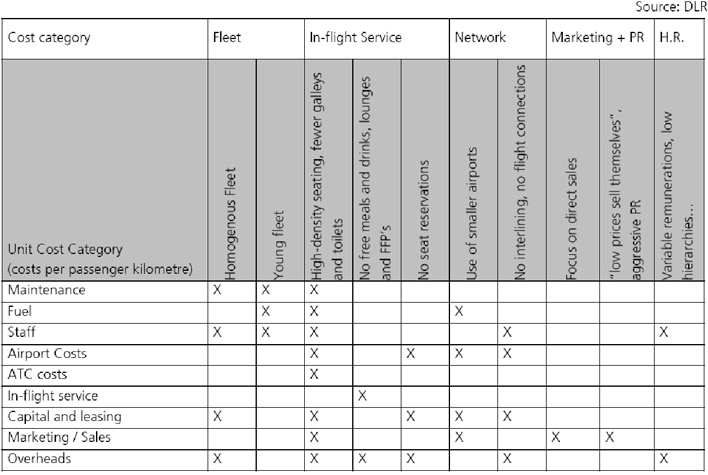- Articles ›
- Operations and IT ›
- Low Cost Carriers - Operational Perspective ! Articles
Low Cost Carriers - Operational Perspective !
Aviation turbine fuel is very high. Navigation charges are high. Landing fees in India is 70 to 80% higher as compared to other airports around the globe. One of the intriguing questions which come in everyone’s mind is how do low cost carriers operate. How they are able to achieve operational efficiency and cut operating cost. Low cost carrier follows price leadership strategy and focus on price reduction.

Table below shows various strategic measures that LCC have taken in order to achieve price leadership.

Many LCC offer short distance flights, no frills, point to point services. With young and homogenous fleet of aircraft it leads to reduction in consumption of fuel, maintenance, staff and overheads. They gain economies of scale in terms of maintenance, spare parts, crew training, tooling and scheduling. Flying point to point enhances aircraft use avoiding disruption due to delayed passengers or luggage missing connecting flights. These plus few other factors ensure that LCC cut their cost to 35-40% lower than the legacy carriers. Most of the low cost carriers do not have business class. So business class space is freed away to squeeze in more economy class seats. This high density of seating arrangement leads to lower unit cost across all categories, since fixed cost can now be attributed to more seats and passengers.
Quicker turnaround time is also one critical factor of LCC’s cost structure. LCC can save cost up to 10% with turn times of 20 minutes. More the plane remains in the sky, better it is for the LCC. Considering that plane is the most expensive asset for the LCC, it needs to use it as much as possible. It achieves this by providing minimal or no catering. If LCC does not provide meals on tray, it saves time on loading and unloading of meals, waste disposal, and cleaning of aircraft, all of which translating into quick turnaround times, hence more flying hours. More flying hours means better asset utilization, more revenues, reduced requirement of flight attendants and janitorial staff which overall brings down the cost per aircraft.
Many of the LCC fly early in the morning or late in the evenings to avoid traffic delays and take advantage of lower landing fees. LCC follows free seating philosophy. It means unreserved seating which in turn encourages passengers to board early and quickly thereby reducing delays. LCC emphasizes on direct sales of tickets, especially over the internet avoiding fees and commissions paid to travel agents and computer reservation systems.
The pricing policy of the low cost carriers is usually very dynamic, with heavy discounts for tickets booked long in advance leading to the generation of new demand from low-yield passengers and heavy bargainers who would not have flown otherwise. LCC also tries to earn ancillary revenue by selling products and services on board. However, not all the LCC follow all the measures. There is still question mark on profitability of this model (barring few airlines) but it has done greater good for the general masses who had never dreamt of flying in the air.
The article has been authored by the editorial team. The content on MBA Skool has been created for educational & academic purpose only.
If you are interested in writing articles for us, Submit Here
Share this Page on:
What is MBA Skool?About Us
MBA Skool is a Knowledge Resource for Management Students, Aspirants & Professionals.
Business Courses
Quizzes & Skills
Quizzes test your expertise in business and Skill tests evaluate your management traits
All Business Sections
Write for Us